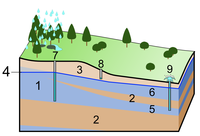
Photo from wikipedia
Submarine fresh groundwater discharging from discrete zones such as conduits overlain by thick sediment remains poorly documented and understood despite common anecdotal accounts of it. We analyzed this phenomenon by… Click to show full abstract
Submarine fresh groundwater discharging from discrete zones such as conduits overlain by thick sediment remains poorly documented and understood despite common anecdotal accounts of it. We analyzed this phenomenon by a suite of variable-density, variably-saturated groundwater flow simulations guided by field studies. The field observations included point flux and salinity measurements using seepage meters spread across the intertidal and the subtidal zones. The discretely measured seepage fluxes in the subtidal region were as high and the salinity was as fresh as those from the intertidal zone. Both fluxes and salinities varied with tides. Two-dimensional simulations of the idealized beach-ocean vertical section with discrete freshwater springs at the base showed the development of seawater recirculation cells along the edge of freshwater discharge plumes emanating from the outlets, causing mixing. Brackish water discharges at the sediment-water interface above where the plume mixes with the recirculating seawater. Sensitivity analyses showed that stronger terrestrial fresh groundwater flow increases the freshwater plume size but does not affect the mixing zone width. Tidal oscillations and a dynamic fresh groundwater flow widened the mixing zones and increased porewater flux across the sediment-water interface. Sediment thickness had a minor effect on the width of both the freshwater plume and its surrounding mixing zone. The subtidal freshwater plume and mixing zone likely represent a unique but potentially ubiquitous setting which hosts dramatic ecological and chemical gradients. Their local biogeochemical niche and coastal scale ecosystem impacts will need to be considered in investigations of coastlines.
Journal Title: Journal of Geophysical Research
Year Published: 2017
Link to full text (if available)
Share on Social Media: Sign Up to like & get
recommendations!